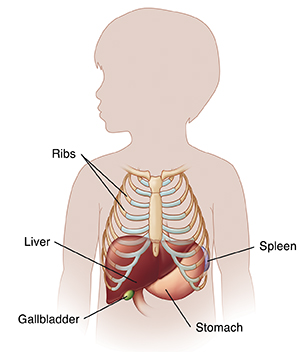When Your Child Needs a Percutaneous Liver Biopsy
A liver biopsy is a quick test that helps see how healthy your child’s liver is. During a percutaneous liver biopsy, a needle is inserted through the skin and into the liver. A small sample of liver tissue is then taken. The tissue is sent to the lab to be studied.

Why does my child need a liver biopsy?
The biopsy helps diagnose a liver problem and see how severe it is. A liver biopsy may be done if:
-
Your child has symptoms of a liver problem, such as jaundice (yellowing of the skin and whites of the eyes).
-
Your child has a chronic (ongoing) liver problem. In this case, the biopsy is done to see how much liver damage has occurred.
-
Other tests have suggested a liver problem, but a diagnosis has not yet been made.
Possible risks and complications of percutaneous liver biopsy
-
Infection
-
Internal bleeding from the liver
-
Damage to organs near the liver (lungs, gallbladder, kidney, or intestines)
Before the biopsy
Before your child’s liver biopsy, alert the healthcare provider to any allergies your child has. Make sure all of your questions are answered before you sign the consent form for the procedure. Make sure your child:
-
Has any blood tests the healthcare provider orders
-
Stops taking medicines as directed (including aspirin and ibuprofen)
-
Does not eat or drink anything for 6 hours before the biopsy
If ultrasound is used
In some cases, an ultrasound is done before the biopsy. During an ultrasound, harmless sound waves are used to create an image of the liver. The healthcare provider uses this image to find the part of the liver from which to take tissue samples. A mark is made on the skin over the best site for the biopsy.
During the biopsy
Before the biopsy starts, your child’s blood pressure, pulse, breathing, and temperature will be checked. Your child will be given medicine to make them drowsy or lightly asleep, or in a state like deep sleep. Your child will not feel any pain during the procedure. During the biopsy:
-
The child lies on the table. The healthcare provider feels to find the liver (on the child’s right side, just below the ribs).
-
The skin over the liver is washed and numbed with medicine. A very tiny incision is made.
-
A small, hollow needle is quickly passed through this incision. A small sample of liver tissue is removed with the needle.
-
A bandage is placed over the incision site. The liver tissue is sent to the lab for testing.
-
Your child may also be rolled onto their right side. A heavy pillow or special bag may be put on the biopsy site. The pressure from the pillow or bag helps stop bleeding.
-
Your child may need to be watched for 3 to 6 hours after the biopsy. Then a blood test is done to check for bleeding. Once no bleeding is found, you can take your child home.
After the biopsy
-
Follow any instructions you are given by hospital staff.
-
Make sure your child gets plenty of rest. Most children can go to school the next day.
-
Running, lifting, or sports should not be done for a few days.
-
Your child may have tenderness or a bruise near the biopsy site. Tenderness may also be felt in the right shoulder. (This is called referred pain. It does not mean there is a problem with the child’s shoulder.) Use over-the-counter pain medicine to relieve discomfort unless instructed otherwise by a healthcare provider.
-
The biopsy results will be ready in a few days. When they are, your child’s healthcare team will discuss them with you.
When to call your child's healthcare provider
Call the healthcare provider right away if your child has any of these:
-
Severe pain near the biopsy site or in the abdomen or chest
-
Severe bruising around the biopsy site
-
Fainting or feeling weak or lightheaded
-
Trouble breathing
-
Fever over 100.4°F (38°C), or as advised by your child's healthcare provider
-
Chills
-
Bleeding from the incision site
-
Vomiting
-
Very pale skin (pallor)
-
Tarry, black stools or a swollen abdomen (signs of internal bleeding)
-
Other symptoms that concern you
Online Medical Reviewer:
L Renee Watson MSN RN
Online Medical Reviewer:
Liora C Adler MD
Online Medical Reviewer:
Marianne Fraser MSN RN
Date Last Reviewed:
11/1/2022
© 2000-2024 The StayWell Company, LLC. All rights reserved. This information is not intended as a substitute for professional medical care. Always follow your healthcare professional's instructions.